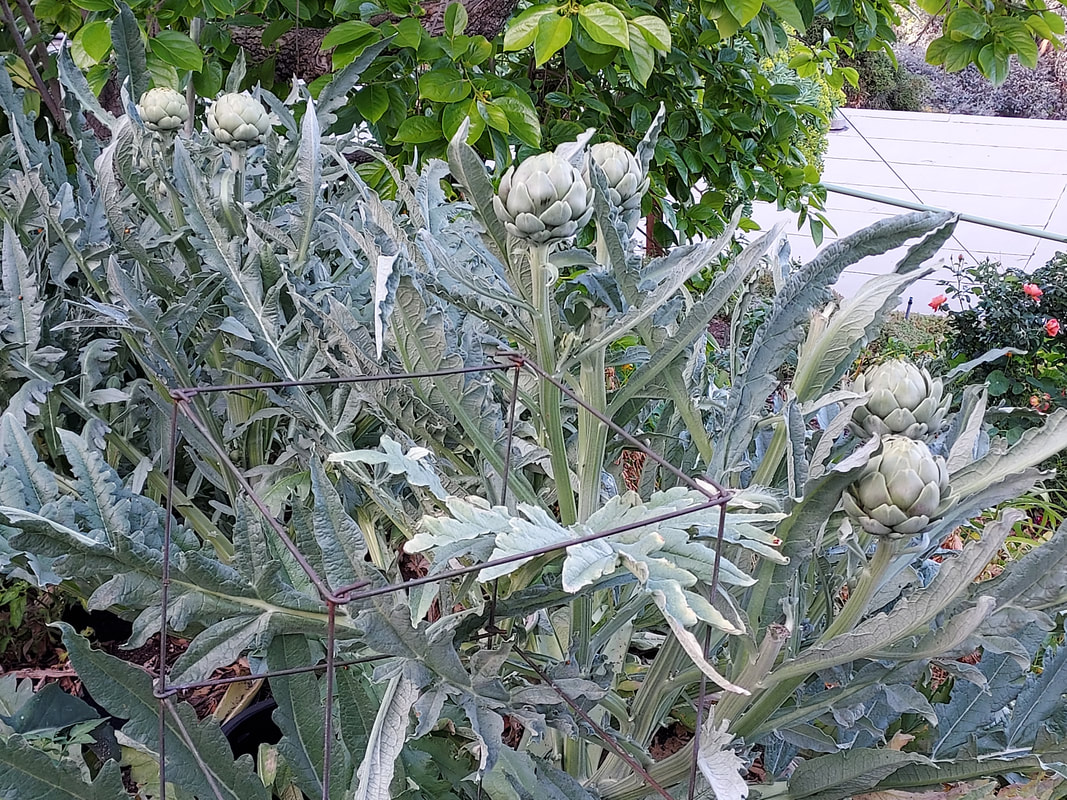| | After this past week of high-90s temperatures, which are certainly beyond my pleasure level to be in the garden, this coming week promises to be back in the mid-60s during the day and mid-40s during the nights. I’d watered my garden two weeks ago, before the heat, and again last night to help it recuperate from last week’s extremes. Now it’ll be able to mellow out this next week. Being well-watered is always the crux enabling the garden plants to be able to deal with extreme temperatures, or to fall victim to them. And this is only the beginning of April, which should be mild-weathered. But maybe this is another example of what used to be as opposed to what is and will become, due to climate warming. My mesembryanthemum (whose botanical name has changed several times since I learned the name, but I don’t bother keeping up with them) always used to bloom from mid-April through Mother’s Day in May. The last several years, its prime bloom has shifted to mid-March, with only a few stragglers now. Daffodils are long gone, freesias came and went, as did grape hyacinths, and bearded irises and Dutch irises are just starting nicely now. Lettuces have long-ago bolted, and peas had their last picking and the plants were pulled and added to the compost pile. Artichokes are starting – we’ve had three meals’ worth already. I’ve picked them when the tips of their scales are barely standing out from the globe, and have been amazed that there was no choke at the base, even though the scales were sufficiently fleshy. I’ll continue this practice with the other plants to see if this was just a peculiarity of that one plant, or is consistent with all the plants that I’d started from that same “Green Globe” seed packet. Before the heat, I’d picked a bunch of “Little Finger” carrots, and they were nicely crunchy and sweet. With last night’s watering following the week’s heat, I’ll wait several days for the roots to again be full of water and hopefully sweet after their stressing out with the heat. Sweet peas blooms are becoming bountiful with my being able to pick a vaseful every third day. I’d also sown another batch of edible peas – the same varieties that I’d sown last fall and we’d finished eating two weeks ago – on the opposite side of the ornamental peas, and about half of them came up. I’ll sow more in the gaps. We’ll see whether we get much of a crop with this planting since it’s been so much warmer than for the overwintering batch. “Wando” peas, especially, are supposedly tolerant of both cold and heat, so we’ll see how they deal with this heat end of the season, especially since they’ll have at least this coming week of comfortable weather. While sweet pea flower pods are poisonous, there’s no problem growing edible peas together with them, since their pods are so visually different. Sweet peas are grayish in color and very fuzzy. Edible peas are bright green (or purple in the case of “King Tut,” “Royal, or “Sugar Magnolia” which I grew this year), smooth and glossy, and much larger and filled out. My crookneck squash plants are up and stretching out, and some of the beans are up as well. I already sowed more seeds in the gaps, and watered them well, at the beginning of the heat spell. The asparagus that I’d started from seed and transplanted last fall are now five inches tall and bushing out. They’ll continue to develop their root systems this summer, so I’ll make sure to keep them well watered as I replant something in the spaces where the fall peas used to be – perhaps another batch of squash and beans and more pepper plants. Cilantro and parsley are still producing nicely but may be toward their end due to this heat. I’ll sow some more during this coolish weather this week just in case it’ll continue so they’ll germinate. Beets and kohlrabi are still small so am keeping them moist until they get to my preferred size of one and one-half inches. The beets I’ll pickle for summer-long salads. Chard continues to be a mainstay of my “greens” plants. Between my 4 plants in different colors that’re more than a year old, I toss the stems and more mature larger outer leaves into the compost pile, and harvest only the tender mid-size leaves, raw in salads and sandwiches, stir-fried, and cooked in soups and stews, burritos and quiches. I didn’t have much luck with several varieties of bok choy and broccoli raab this year, seeding every two weeks into both nursery packs and into the growing beds and getting decent germination but having most bolt (go to seed) shortly after transplanting before producing much foliage for me to harvest. I guess I’ll blame that too on the flip-flopping weather. My several tomato plants that I’d transplanted almost two months ago are all doing nicely and have sorted themselves into different rates of growth due to some of them being shaded by the breadseed poppies that had germinated from last year’s crop. I can’t bear to remove the poppies before they bloom, so I’ll just have to let the tomatoes fend on their own until the poppies are done. This’ll give the tomatoes lots more time to develop really extensive root systems, which will ultimately enable them to produce even more tomatoes! At least that’s what I’m telling myself…. For more garden tasks, see April. For my main topic blogs, see Homepage. |
|
2 Comments
LYNND
5/5/2022 11:38:28 am
This is a beautiful blog!
Reply
12/7/2022 12:16:37 am
Click on the given link to read more such post.https://ourtechtime.com/palmdales/
Reply
Leave a Reply. |
Categories |














 RSS Feed
RSS Feed